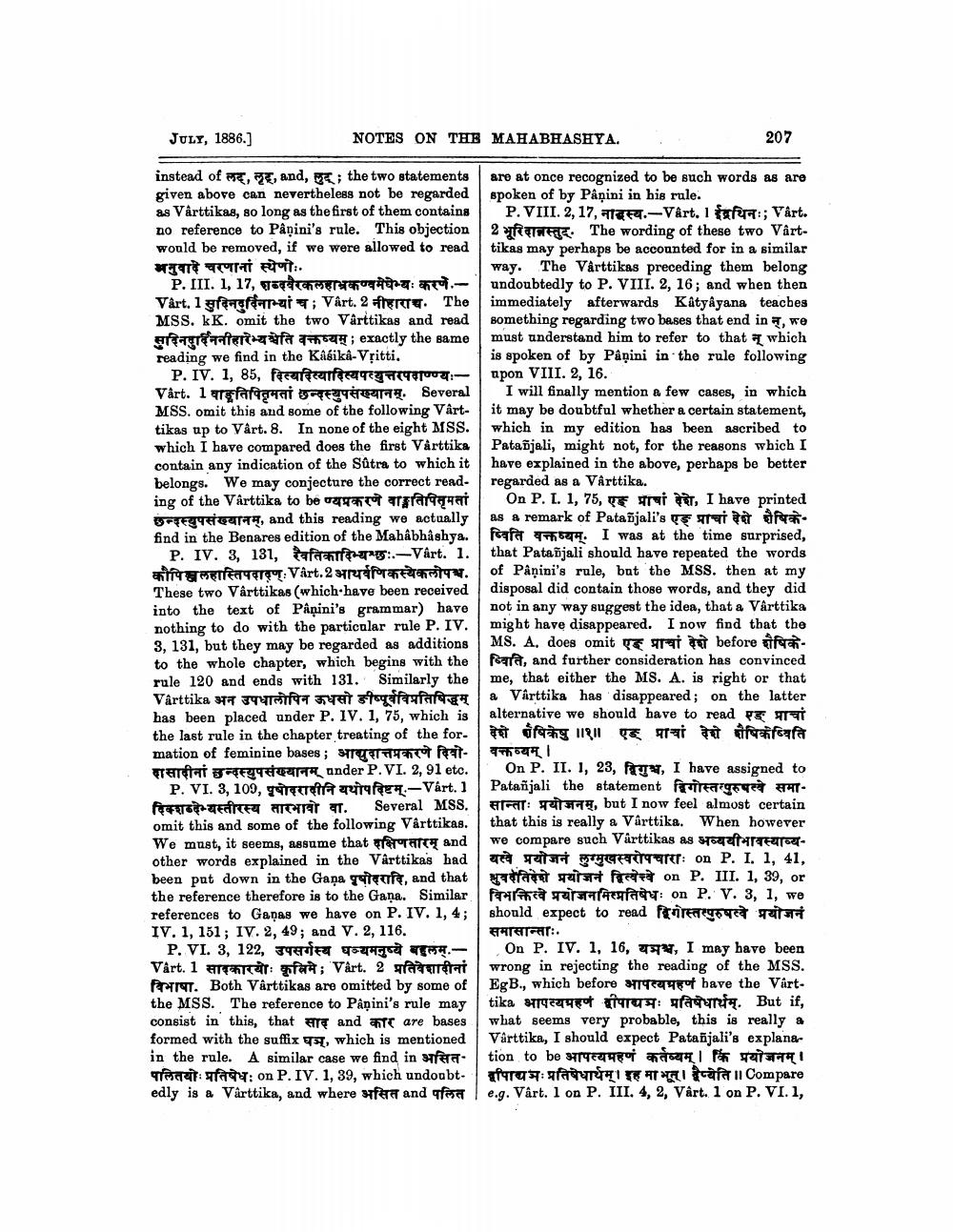________________
JULY, 1886.]
NOTES ON THE MAHABHASHYA.
207
instead of लद, लुह, and, लु, the two statements are at once recognized to be such words as are given above can nevertheless not be regarded spoken of by Paņini in his rule. as Vârttikas, so long as the first of them contains P. VIII. 2, 17, 11.- Vårt. 1 ; Vårt. no reference to Pâņini's rule. This objection2 f t The wording of these two Vârtwould be removed, if we were allowed to read tikas may perhaps be accounted for in a similar मनुवादे चरणानां स्थणो.
way. The Vårttikas preceding them belong P. III. 1, 17, MENTO : .- undoubtedly to P. VIII. 2, 16; and when then Vårt. 1 gramafdrui; Vârt. 2 frere. The immediately afterwards Katyayana teaches MSS. KK. omit the two Värttikas and read something regarding two bases that end in, we aragrafferiaza 28; exactly the same must understand him to refer to that which reading we find in the Kabika-Vșitti.
is spoken of by Pâņini in the rule following P. IV. 1, 85, facule cuffie T Z : upon VIII. 2, 16. Vart. 1 वाकृतिपितृमतां छन्दस्युपसंख्यानम्. Several I will finally mention a few cases, in which MSS. omit this and some of the following Vârt- it may be doubtful whether a certain statement, tikas up to Vârt. 8. In none of the eight MSS. which in my edition has been ascribed to which I have compared does the first Vårttika Patañjali, might not, for the reasons which I contain any indication of the Sûtra to which it have explained in the above, perhaps be better belongs. We may conjecture the correct read- regarded as a Vårttika ing of the Virttika to be ण्यप्रकरणे वाजतिपितृमतां On P. L. 1,75, एक प्राचां देश, I have printed bryter, and this reading we actually as a remark of Patañjali's T a le or find in the Benares edition of the Mahâbhâshya. Para T52. I was at the time surprised,
P. IV. 3, 131, tafashifany.-Vårt. 1. that Patañjali should have repeated the words a ufert: Várt.2 raforat . of Påņini's rule, but the MSS. then at my
These two Vârttikas (which have been received disposal did contain those words, and they did into the text of Påņini's grammar) have not in any way suggest the idea, that a Vårttika nothing to do with the particular rule P. IV. might have disappeared. I now find that the 3, 131, but they may be regarded as additions MS. A. does omit एद प्राचां देशे before शैषिकेto the whole chapter, which begins with the fora, and further consideration has convinced rule 120 and ends with 131. Similarly the me, that either the MS. A. is right or that Vârttika 377 T T aloqarasa
a Virttika has disappeared ; on the latter has been placed under P. IV. 1, 75, which is alternative we should have to read एड प्राचां the last rule in the chapter treating of the for. Orang 1111 qraf t arafa mation of feminine bases ; sprere t T9h5241 Tartat 5 YTH ander P. VI. 2, 91 etc. On P. II. 1, 23, RUN, I have assigned to P. VI. 3, 109,
T etra uren-Várt. 1 Patali jali the statement दिगोस्तरपुरुषत्वे समा. f azerceu a T. Several MSS. Ara: To , but I now feel almost certain omit this and some of the following Vårttikas. that this is really a Várttika. When however We must, it seems, assume that TATTY and we compare such Varttikas as अव्ययीभावस्याव्यother words explained in the Vårttika's had TO
Tart: on P. I, 1, 41, been put down in the Gaņa auf, and that at past feed on P. III. 1, 39, or the reference therefore is to the Gaņa. Similar F ica Trat on P. V. 3, 1, we references to Ganas we have on P. IV. 1, 4; should expect to read दिगोस्तत्पुरुषत्वे प्रयोजनं IV. 1, 151; IV. 2, 49; and V. 2, 116.
HATET HT:. P. VI. 3, 122, RT 52H
.
On P. IV. 1, 16, N, I may have been Vårt. 1 HTTür: fan; Vårt. 2 qat wrong in rejecting the reading of the MSS. FRITT. Both Vârttikas are omitted by some of EgB., which before 1944 ut have the Vårt. the MSS. The reference to Panini's rule may tika 71972980 : aacuta. But if, consist in this, that are and are are bases what seems very probable, this is really a formed with the suffis Tal, which is mentioned Vürttika, I should expect Patañjali's explanain the rule. A similar case we find in sfera. tion to be आपत्यग्रहणं कर्तव्यम् । किं प्रयोजनम् । freitfady: on P.IV. 1, 39, which undoubt afragrau T a ft i Compare edly is a Várttika, and where are and fa le.g. Vårt. 1 on P. III, 4, 2, Vârt. 1 on P. VI. 1,




